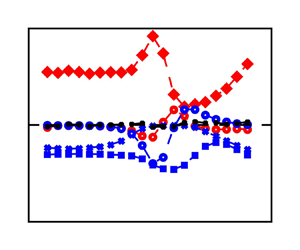No CrossRef data available.
Article contents
Energy thickness in turbulent boundary layer flows
Published online by Cambridge University Press: 13 January 2025
Abstract

In this study, we investigate the properties of energy thickness  $\delta _3$ in turbulent boundary layer (TBL) flows, a parameter derived solely from the mean streamwise velocity (
$\delta _3$ in turbulent boundary layer (TBL) flows, a parameter derived solely from the mean streamwise velocity ( $U$) profile. Through an analysis of the energy integral equation for zero pressure gradient TBLs, we establish a close relationship between turbulent kinetic energy (TKE) production and
$U$) profile. Through an analysis of the energy integral equation for zero pressure gradient TBLs, we establish a close relationship between turbulent kinetic energy (TKE) production and  $\delta _3$, offering a practical method to estimate TKE production, which is particularly useful in physical experiments where direct measurements are challenging. The significance of
$\delta _3$, offering a practical method to estimate TKE production, which is particularly useful in physical experiments where direct measurements are challenging. The significance of  $\delta _3$ becomes even more pronounced in TBLs under pressure gradient. Through extensive analysis of numerical and experimental data, we show that the ratio between
$\delta _3$ becomes even more pronounced in TBLs under pressure gradient. Through extensive analysis of numerical and experimental data, we show that the ratio between  $\delta _3$ and the momentum thickness
$\delta _3$ and the momentum thickness  $\delta _2$ is a promising criterion for predicting flow separation. Moreover, we derive a new energy integral equation for TBLs under arbitrary pressure gradients, and provide approximations for TKE productions terms by
$\delta _2$ is a promising criterion for predicting flow separation. Moreover, we derive a new energy integral equation for TBLs under arbitrary pressure gradients, and provide approximations for TKE productions terms by  $R_{uv}\,\partial U/\partial y$ and
$R_{uv}\,\partial U/\partial y$ and  $R_{uu}\,\partial U/\partial x$, and dissipation term by the mean shear. Here,
$R_{uu}\,\partial U/\partial x$, and dissipation term by the mean shear. Here,  $x, y$ represent the streamwise and wall-normal directions, respectively, and
$x, y$ represent the streamwise and wall-normal directions, respectively, and  $R_{uu}$ and
$R_{uu}$ and  $R_{uv}$ are the Reynolds normal and shear stresses. The accuracy and robustness of the new energy integral equation and the approximation equations are validated using direct numerical simulations data. Our results show that the TKE production by
$R_{uv}$ are the Reynolds normal and shear stresses. The accuracy and robustness of the new energy integral equation and the approximation equations are validated using direct numerical simulations data. Our results show that the TKE production by  $R_{uv}\,\partial U/\partial y$ and the overall productions consistently remain positive, reflecting a continuous conversion of mean kinetic energy into TKE across all TBLs. However, under strong favourable pressure gradients, TKE production by
$R_{uv}\,\partial U/\partial y$ and the overall productions consistently remain positive, reflecting a continuous conversion of mean kinetic energy into TKE across all TBLs. However, under strong favourable pressure gradients, TKE production by  $R_{uu}\,\partial U/\partial x$ becomes negative, indicating a reverse energy transfer from TKE to mean kinetic energy.
$R_{uu}\,\partial U/\partial x$ becomes negative, indicating a reverse energy transfer from TKE to mean kinetic energy.
- Type
- JFM Papers
- Information
- Copyright
- © The Author(s), 2025. Published by Cambridge University Press



